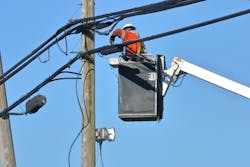In 1995 a group of fiber-optic company executives, managers, supervisors, consultants, and trainers realized that almost all installation errors resulted from inadequate knowledge of the rules of fiber installation. Led by Jim Hayes, then the president of FOTEC and now president of the Fiber Optic Association (FOA), this group—pictured on this page—founded the FOA. The explicit objective was to create a mechanism by which adequate knowledge and experience could be verified and certified.
Since its establishment, the FOA has developed 14 basic and advanced certifications and has issued more than 110,000 certifications worldwide. Despite these significant accomplishments, installation by inadequately knowledgeable and experienced personnel continues.One reason for this continuation is insufficient knowledge of how to qualify fiber installers. In this article, I present 10 questions you should ask, and answers you should receive, to avoid the selection of such unqualified or underqualified personnel.
Question 1: Will each technician be certified in each of the activities to which he/she will be assigned?
The best possible answer is yes.
Question 2: What authority certified the technician?
As one of the founders of the Fiber Optic Association, this author considers the FOA to be the best, but not the only sufficient, answer.
Question 3: What certification level will each technician have?
The best answer is advanced certification. The basic FOA certification (CFOT) requires broad understanding. The advanced certifications, Certified Fiber Optic Specialist (CFOS), requires increased depth of understanding and experience. Find more detail here.
Question 4: What number of repetitions does each technician have for each of his/her activities?
For interpretation of these answers, I present the following 5 guidelines.
- A higher number is better than a lower one.
- Are the repetitions verified with a record, such as a logbook?
- Does the number represent successful, low-loss, reliable repetitions, as opposed to attempts?
- How many of the repetitions are of the installation, splicing, or testing methods that will be used in the current project?
- Do the numbers of repetitions exceed recommended minimums? (See Table)
Recommended Minimum Repetitions Cable pulling and end preparation: 300 Patch cable installation and dressing: >500 Connector installation: >500 Fusion splicing: >500 Insertion loss testing: >1000 OTDR testing: >1000 Reflectance and ORL testing: >1000 |
Question 5: To what industry standard(s) will the installation be performed?
The best answers include NECA/FOA-301; BICSI Information Technology Systems Installation Methods Manual (ITS IMM), ANSI/TIA-568-D, ANSI/TIA-606, Section 770 of the National Electrical Code, and NECA 1.
Question 6: How many different fiber-optic installation projects has the candidate company performed?
This number can indicate limited or extensive experience.
Question 7: Does the candidate company’s experience include the type of activities and number of repetitions required by the current project?
Going from a project of 100 connectors to one requiring 10,000 may exceed the candidate company’s capabilities.
Question 8: What references will the candidate company provide for prior projects of the same nature and size as the current project?
Actually speaking to these references can provide useful insight into the candidate’s work habits and level of customer service.
Question 9: What fiber installation and testing equipment does the candidate company own?
Experience requires and results in ownership of the appropriate types and quantities of equipment. Equipment rentals can be a sign of limited experience.
Question 10: Will the candidate company subcontract any activity?
The answer reveals whether the candidate company has the number of certified and qualified personnel sufficient for the project under consideration. If there will be subcontracting, will each technician of the subcontractor be certified as described in Question 1?
With these questions, the hiring authority can avoid the types of errors that led to the founding of the FOA. Such errors include significant risk and financial consequences from installation problems, lawsuits, and increased costs. Hiring inadequately knowledgeable and experienced installers can be avoided.
Contact Pearson Technologies at ptnorwire.com, [email protected], 770-490-9991
About the Author
Eric Pearson
President, Pearson Technologies Inc.
For 40 years, Pearson Technologies Inc. has provided fiber optic consulting, and installation and design training in North and Central America, Europe, and S Korea. In addition to basic and advanced training, Pearson Technologies provides technical support in legal cases involving patents, cable damage, repair, and installation deficiencies. Contact Pearson Technologies at: www.ptnowire.com, [email protected], 770-490-9991.

